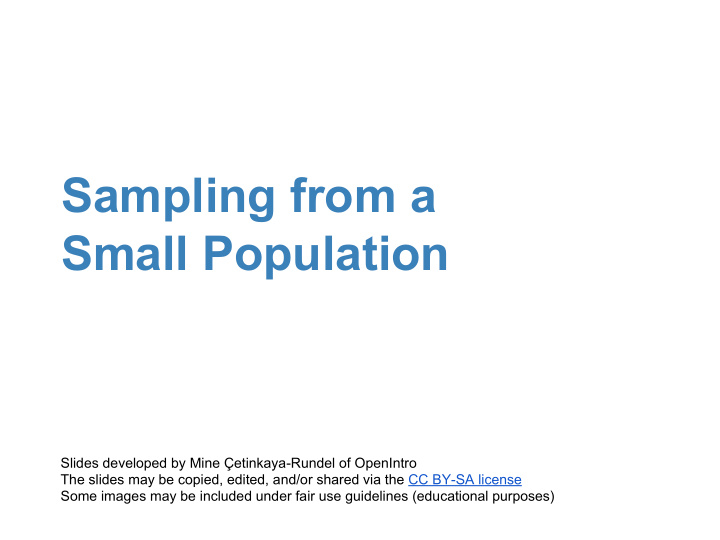



Sampling from a Small Population Slides developed by Mine Çetinkaya-Rundel of OpenIntro The slides may be copied, edited, and/or shared via the CC BY-SA license Some images may be included under fair use guidelines (educational purposes)
Sampling with replacement When sampling with replacement, you put back what you just drew. ● Imagine you have a bag with 5 red, 3 blue and 2 orange chips in it. What is the probability that the first chip you draw is blue? 5 O , 3 O , 2 O ● Suppose you did indeed pull a blue chip in the first draw. If drawing with replacement, what is the probability of drawing a blue chip in the second draw? 1st Draw - 5 O , 3 O , 2 O 2nd Draw - 5 O , 3 O , 2 O P(2nd chip B | 1st chip B) = 3 / 10 = 0.3
Sampling with replacement (cont.) ● Suppose you actually pulled an orange chip in the first draw. If drawing with replacement, what is the probability of drawing a blue chip in the second draw? 1st Draw - 5 O , 3 O , 2 O 2nd Draw - 5 O , 3 O , 2 O P(2nd chip B | 1st chip O) = 3 / 10 = 0.3 ● If drawing with replacement, what is the probability of drawing two blue chips in a row? 1st Draw - 5 O , 3 O , 2 O 2nd Draw - 5 O , 3 O , 2 O P(1st chip B) x P(2nd chip B | 1st chip B) = 0.3 x 0.3 = 0.09
Sampling with replacement (cont.) When drawing with replacement, probability of the second chip being blue does not depend on the color of the first chip since whatever we draw in the first draw gets put back in the bag. Prob(B | B) = Prob(B | O) In addition, this probability is equal to the probability of drawing a blue chip in the first draw, since the composition of the bag never changes when sampling with replacement. Prob(B | B) = Prob(B) When drawing with replacement, draws are independent.
Sampling without replacement When drawing with replacement you do not put back what you just drew. ● Suppose you pulled a blue chip in the first draw. If drawing without replacement, what is the probability of drawing a blue chip in the second draw? 1st Draw - 5 O , 3 O , 2 O 2nd Draw - 5 O , 2 O , 2 O P(2nd chip B | 1st chip B) = 2 / 9 = 0.22 ● If drawing without replacement, what is the probability of drawing two blue chips in a row? 1st Draw - 5 O , 3 O , 2 O 2nd Draw - 5 O , 2 O , 2 O P(1st chip B) x P(2nd chip B | 1st chip B) = 0.3 x 0.22 = 0.066
Sampling without replacement (cont.) When drawing without replacement, the probability of the second chip being blue given the first was blue is not equal to the probability of drawing a blue chip in the first draw since the composition of the bag changes with the outcome of the first draw. Prob(B | B) ≠ Prob(B) When drawing without replacement, draws are not independent. This is especially important to take note of when the sample sizes are small. If we were dealing with, say, 10,000 chips in a (giant) bag, taking out one chip of any color would not have as big an impact on the probabilities in the second draw.
Practice In most card games cards are dealt without replacement. What is the probability of being dealt an ace and then a 3? Choose the closest answer. (a) 0.0045 (b) 0.0059 (c) 0.0060 (d) 0.1553
Practice In most card games cards are dealt without replacement. What is the probability of being dealt an ace and then a 3? Choose the closest answer. (a) 0.0045 (b) 0.0059 (c) 0.0060 (d) 0.1553 P(ace, then 3) = (4 / 52) x (4 / 51) ~ 0.0060
Recommend
More recommend